The premise is simple: read one comic every day for the entire year. It seems like a simple task but there is no way that I read 365 comics last year, even if you count the individual issues in collections. So, this year, I am committing myself to this reading challenge, in the hope that I can broaden my reading habits and fully engage with my favorite hobby again.
I guess my reading this week has been influenced by two things. The first is the release of a movie I have not seen, but as a result of it hitting the cinemas, the earlier films have been popping up all over my television. So, let’s give a nod to Indiana Jones.
And secondly, there is a new Rocketeer comic out on the stands (out on Wednesday, July 12th, a few days after I write this but a few days before my week’s reading began). With the advent of a new Rocketeer coming out, it would almost be a crime not to read at least some of the earlier releases. Plus, any excuse to dip into the Rocketeer.
MFR ON YOUTUBE (latest video)
Help us reach 5K Subs!
Both Indiana Jones and the Rocketeer are good old fashioned adventure characters with stories most often set around the same period in history. Yes, there are a large number of evil Nazis in both franchises. There are also a lot of femme fatales, hapless assistants, and plucky young kids.
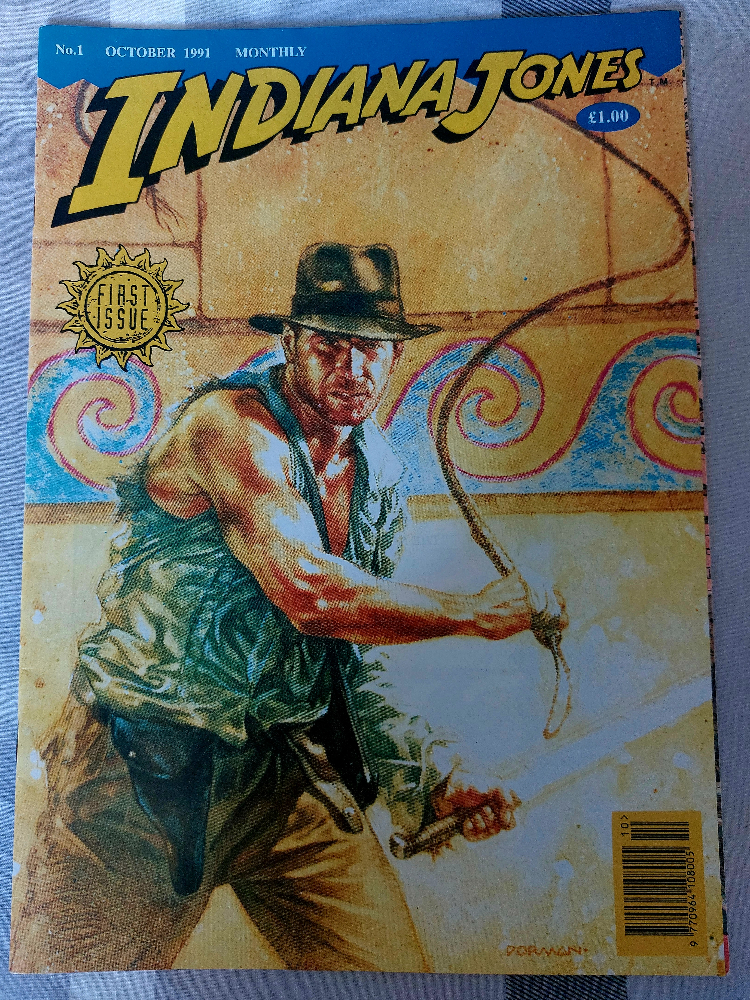
Credit: Trident Comics
Comic Number 189: Indiana Jones #1 (Trident Comics)
I’m British. I lived in a small village growing up that had a lonesome, single shop. Even the nearest town didn’t have a clue what a specialized comic book shop was, therefore most of my reading in the late 1980’s and early 1990’s came from British reprints that I could order from the local shop.
In 1991 Trident Comics released their first issue of Indiana Jones, which repackaged the Dark Horse comic The Fate of Atlantis and then added older Adventure stories as a backup strip.
Indiana Jones and the Fate of Atlantis is a point-and-click adventure game with a tightly developed plot and a host of puzzles to solve. It is one of the few games I remember playing and enjoying (I’m not a video gamer). The comic book adaptation was written by William Messner-Loebs and illustrated by Ban Barry and Karl Kessel, all of whom I don’t really know. None of the names jump out at me from previous work, but they have all worked on a lot of adventure style comics before working on this Indiana Jones story, and you can tell.
The plot is perfect Indiana Jones with a set up and pacing exactly the same as Raiders of the Lost Ark. The artwork is dynamic with care given to the details in each panel to set up the mysteries without losing the adventurous spirit. The characters are emotive with complex facial expressions that at times could be read as overacting, however that’s the nature of the franchise. Each movie has a few expressive, ham actors, and we would feel robbed if they were left out. This comic has everything you could want from Indiana and friends. It is a joy to read and every page provides satisfying entertainment, if not groundbreaking comic storytelling.
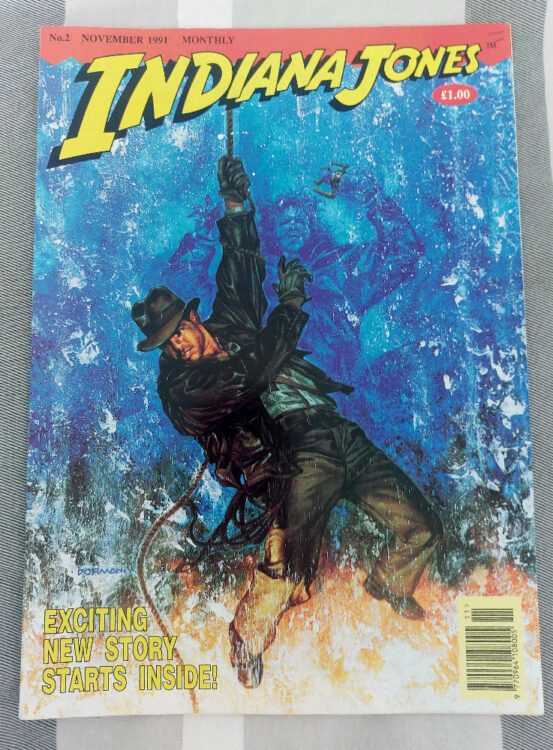
Credit: Trident Comics
Comic Number 190: Indiana Jones #2 (Trident Comics)
In issue two of Indiana Jones, Trident Comics introduced a backup strip which was a reprint of a Further Adventure story from 1983. The Ikons of Ikammanen is a little bit more goofy than the lead story, with the cast being much more over the top and the story rattles on at a break-neck speed.
What is more interesting about this story are the creators. The X-Men powerhouse of artists, John Byrne and Terry Austin, wrote and illustrated Ikons, with Joe Rosen and Bob Sharen. These two worked with Chris Claremont on some of the most famous X-Men comics and that non-stop, constant danger, is at the heart of this Indiana Jones story. Broad strokes are taken with the characters and, at times, they feel like reductions of more complex people, like an abridged version of a novel. That doesn’t stop it being an entertaining read, and you can’t quibble with the artwork. It is very 1980s and provides an interesting comparison to the lead story.
Trident Comics, themselves, have an interesting past, and one that seems at odds with publishing a corporate tie-in comic like Indiana Jones. Trident championed new comic creators from its inception in 1989 to its demise in 1992 at the hands of corporate buyouts. Anyone in the industry today would recognize the creators who worked with Trident: Neil Gaiman, Grant Morrison, and Mark Millar with his first ever published comic work (possibly — I have read several different comics/publishers claiming this one). I would love to get my hands on a Trident archive and see where so many great British creators started out.
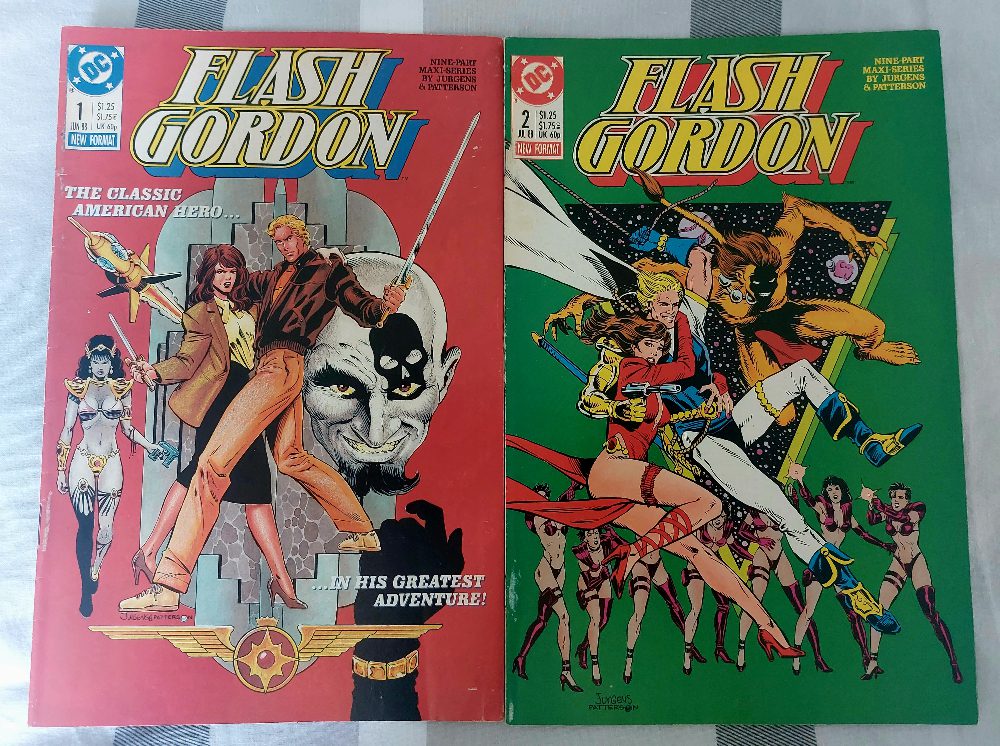
Credit: DC
Comic Number 191: Flash Gordon #1-2 (DC 1988)
Before I get to the Rocketeer (waiting for the new release tomorrow) I’ve opened up the nine issue 1988 maxi-series, Flash Gordon. Another pure adventure story, Flash Gordon has links with the early 20th century movie serials that influenced Dave Stevens’ creation of the Rocketeer. Ten to fifteen minute, black and white chapters told the adventures of Flash Gordon, Superman, Cody and the Rocket Men, and Dick Tracy. Colloquially known as cliff-hangers, the movie serials were the closest thing to live action comics that we’ve ever got.
The 1988 Flash Gordon title is an homage to that and to the original Flash Gordon created by Alex Raymond. Written and penciled by Dan Jurgens and inked by John Workman, the story follows aging athlete, Flash, as he gets whisked away to a distant galaxy where his life is immediately forfeit. Plucky reporter Dale Arden is also a victim of Dr. Zarkov’s hubris, and quickly becomes a feminist voice in an overtly discriminatory world. Unfortunately for the readers, in the first few issues, Arden isn’t written very well and the attitudes of the other characters, including Flash, demean her standing and opinions. The comic feels like it is mocking her and feminism in general. The nature of the story means that this might change over time as the characters evolve but it is jarring in the first two issues.
Other than that, Flash Gordon is a fun read. It’s brash, cliched, and ends each issue on a drastic, life threatening cliff hanger. I’m going to finish the series, partly because I’m interested to see how it progresses, and partly because I forgot I had the entire run (which leads me to believe it might not improve because I have no memory of reading it all).
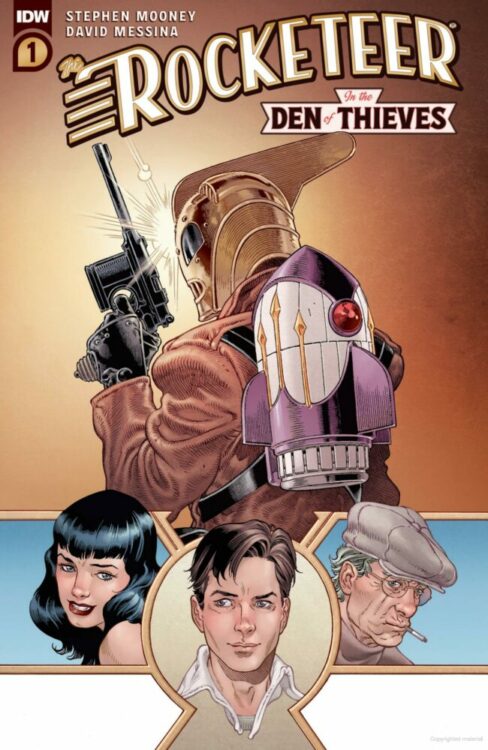
Credit IDW Publishing
Comic Number 192: Rocketeer in The Den of Thieves #1 (IDW and brand new)
It seems like forever since a new Rocketeer comic was released (The Great Race was last year but before that, Hollywood Horror was ten years ago. Was there anything bridging that gap?) and The Den of Thieves comes out swinging for a home run. Just the design and the layout for the first two pages are perfect Rocketeer comics. They include cinematic panels with interlocking and overlapping art decor page frames which are apart from the panels themselves but create an overall classic cinema visual motif. And then the full page splash on page two with a rocket man bursting out of the confines of the comic, hanging in the page, larger than life. The effect is spectacular and it only gets better from this moment onward.
The Den of Thieves is written by Stephen Mooney and illustrated by David Messina, both of whom are holding nothing back. The narrative is what I would call a pure classic adventure story, Nazis and all. All of the elements from the original Dave Stevens’ comic are here; characters and narrative tone. The action is over the top and never too serious but at the same time packed with danger. Messina’s artwork is powerful and in your face; the characters speed out of the page towards you caring not a jot for any fourth wall. His character work is exemplary as he is able to breath depth and emotion into the larger than life cast of what so easily could be two dimensional characters.
There is something sincere about this version of the Rocketeer that not all of the previous renditions have been able to capture. Mooney is clearly a lover of this type of story and his passion comes through in the script which skates on the line between genius and cliché. It doesn’t want to be too serious, nobody wants this to be high Art but at the same time we don’t want a sci-fi movie of the week. No Sharknado here. Between them, Mooney and Messina have produced a perfect homage to Dave Stevens’ character as well as a purely entertaining comic.
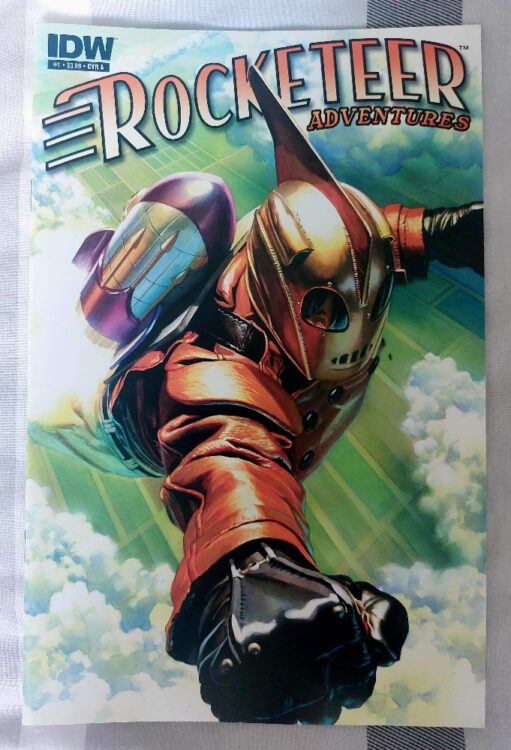
Credit IDW Publishing
Comic Number 193: Rocketeer Adventures #1 (IDW, 2011)
I could have re-read Dave Stevens original adventures of Cliff and Betty, but I have read them over and over. What I haven’t read in a long time are the IDW anthology comics that printed new, short stories of the Rocketeer written and illustrated by a host of top creators. In issue one, John Cassaday introduces the central leads, Cliff and Betty, in an action sequence involving gangsters, machine guns, and massive exploding rockets. Cassaday uses the simple story to demonstrate the interactions between the two leads, highlighting their complex relationship which is both charming and dubious. Just like Homer and Marge Simpson, you do kind of wonder why these two people are still in a relationship, but then again, that is part of the charm.
This is followed up by a story from Mike and Laura Allred. Entitled Home Again, the narrative is a tale within a tale, neither of which seem to have much purpose. It sort of reintroduces ideas from the original comics but nothing seems to go anywhere or have any purpose in the story, except to be an excuse to draw the Rocketeer zipping around the big city. I’m not a fan of this middle adventure because there isn’t any actual adventure and I’m not sure what the point of it is.
However, the third tale in this issue more than makes up for the weak middle child. Kurt Busiek’s Dear Betty is an outstanding read and the artwork by Micheal Kaluta really makes this a special adventure. The narrative is told in the form of letters from Cliff to Betty while he is away fighting during the Second World War. The adventure and excitement of being in the army, and occasionally putting on the Rocketeer suit, is countered with the constant threat of injury or worse and this is played out through Betty’s reactions. She is trying to live her life with the constant fear overshadowing her day to day routines. It is a moving and beautifully illustrated story.
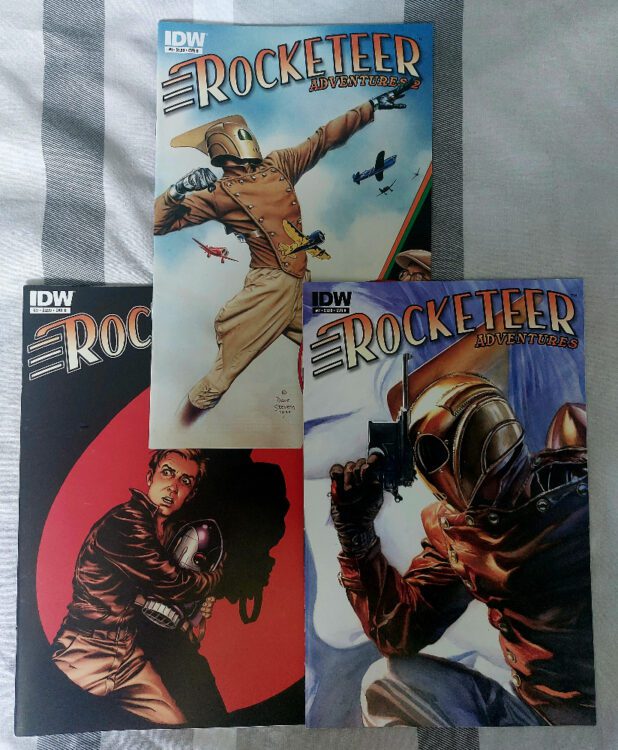
Credit IDW Publishing
Comic Number 194: More Rocketeer Adventure comics (#2-3 and Volume 2 #1)
I’ve zipped through several issues of the Rocketeer Adventures because once you get going, it’s tricky to stop. I remember thinking at the time that the short story format was okay but I wanted something longer, more in depth. Reading them all back now, I enjoy them a whole lot more. There’s something to be said for good things in small packages. Some of the later, multi issue stories, didn’t manage to successfully fill their narratives which left meandering plots or awkward filler scenes. When you only have a handful of pages, you are forced to be concise and direct in the storytelling. The “Junior Rocketeers” story from issue three, written by Jonathan Ross and illustrated by Tommy Lee Edwards, crams a lot of narrative into a few pages. This is partially achieved because Ross enjoys filling his panels and pages with text but also because Edwards is a master visual storyteller. His artwork is complex, emotive, and highly detailed. Those eight pages have a movie worth of entertainment.
“Betty Saves the Day” by Darwyn Cooke (from issue 2) is a beautiful homage to the movie serials that inspired the character. It starts with a page of black and white panels, all equal in size, that reads like a recap of the series so far. Then it switches into Dave Stewart’s explosive colors to continue the story. There is action and adventure, a little bit of romance and cheekiness before leading into the obligatory cliffhanger. The comic is such a wonderfully simple idea, executed with style and panache. It’s almost my favorite story out of these three issues.
However, for full on tongue-in-cheek goodness and outstanding artwork, look no further than Peter David and Bill Sienkiewicz’ “The Ducketeer!” in issue one of the second volume. Packed with humor, pop culture references, extraordinary art, and in continuity framing (as far as possible with the Rocketeer comics) this short story touches so many different bases. It references historical animation practices, modern art principles, postmodern narrative frameworks, and a whole host more. All of this is wrapped into a story that could, in different hands, be an unforgettable, straightforward Rocketeer story. This is top notch comic book storytelling.
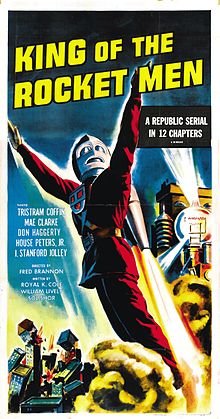
Comic Number 195: King of the Rocket Men Chapter 1 to 4 (as at time of writing)
Reader: Now, Darryll, we’ve talked about this kind of thing before. This is not a comic. Comics are sequential illustrations printed on paper so that you can buy them at your local shop/convention.
Darryll: But are they, though, are they?
I think if I had the time to do enough research (not a euphemism for watching countless hours of old movie serials) I could write an essay about the importance of and similarities between comics and movie serials of the early 20th century — especially titles like King of the Rocket Men and Flash Gordon Conquers the Universe. These old black and white serials have so much in common with comics and the characters jump back and forth between mediums so that it’s difficult to know which had the most influence on the other. Elements of the Batman mythos, for example, actually come from the 1943 Columbia Pictures serial and weren’t originated in the comics, just as Harley Quinn started out as a cartoon character in the 1990s before becoming a regular addition to the monthly comics.
The way that each chapter of the serials are plotted and the fast pace of the narrative often feels like a monthly comic. There is plenty of action around which the actual plot revolves, this is to keep the reader/audience engaged. In King of the Rocket Men, the narrative follows a scientist who is trying to weed out a spy and traitor within the Science Associates, who is stealing secrets to sell to enemies of America. The mystery element of the plot is always backed up with a good fight scene or car chase. A lot of the exposition and narrative elements are relayed during sequences of action. For example, the spy equipment that Dr. Vulcan uses to protect his hideout is revealed to the audience while one of his minions is involved in a car chase.
The serial chapters had a limited amount of time in which to move their story forward each week but they also had to be engaging enough to get the audience to come back week after week. Sound familiar? Comics had (and indeed still have) limited pages counts with which to capture the imagination of the readers. Each issue had to feel like value for money and entertaining enough that in a month’s time the kids, and their parents, would be looking for the same title on the newsstands. The cliffhanger endings were one technique but not the only one. The elements of mystery and suspense played a major role as well. If you missed a Chapter then you might miss the big villain reveal, or a spectacular stunt sequence, the same was true of the monthly comics. The serials were awe inspiring and addictive, just like the comics of the time. These days television series have moved on and share less in common with the comics that are released each month. What the audience expects from each medium is different now than it was in the 1930s and 1940s.
The links between mediums were much stronger in the past, even taking into account the massive MCU. These days comics and movies/television series tend to have a shared point of narrative origin but then their aims in production are different: and rightly so. What we expect from the cinema is not what we should be expecting from a comic. However, I feel that there was a better synergy between comics and movie serials, or radio and theater productions, in the early days where they each seemed to promote the other. There was no hierarchy where one medium was superior to another, and less gate-keeping over the characters because people could accept that different mediums had different takes on the same source material.
Although, I could be wrong. That’s where the research would come in handy. #futureplans
I’ve enjoyed reading these adventure comics this week. They have been really escapist, allowing me to switch off from the world, which is a good enough reason to read a comic.

